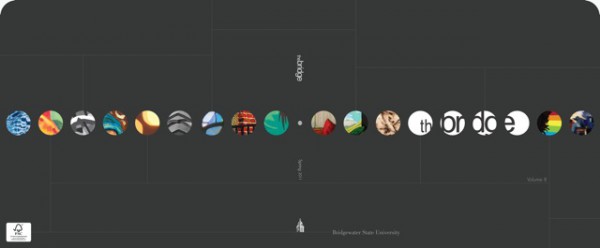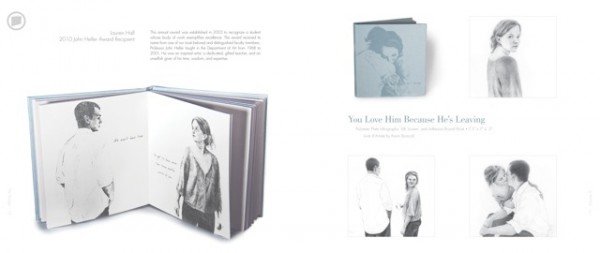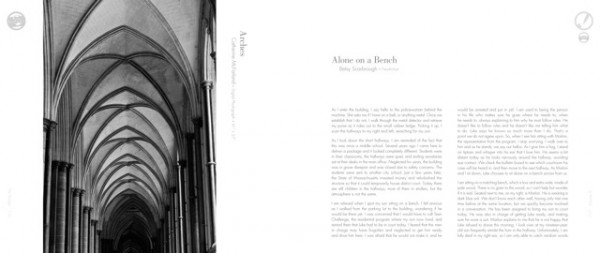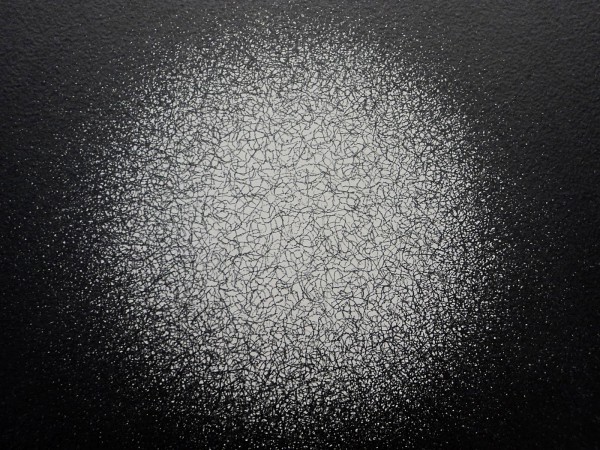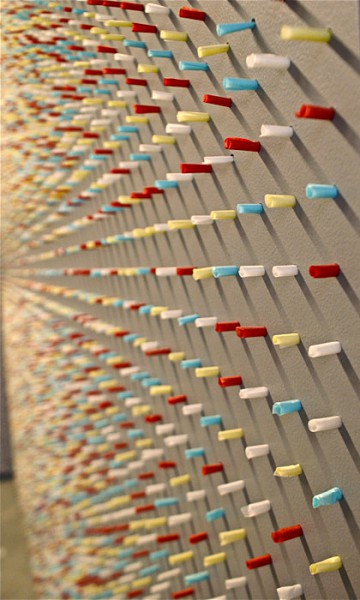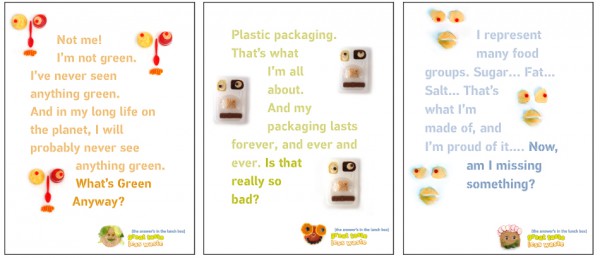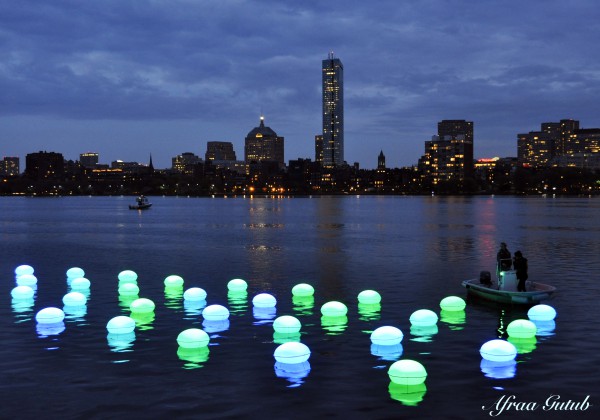
Aaliah Al-Aali Re-Designs The Holy Qur’an
 Some of the most inspiring design comes from a designer’s willingness to take a risk.
Some of the most inspiring design comes from a designer’s willingness to take a risk.
Aaliah Al-Aali, a graduate from the Masters program in Graphic Design from The New England School of Art & Design at Suffolk University, boldly decided to re-design The Holy Qur’an for her thesis project.
Through an exploration in calligraphy and pattern, Aaliah introduced the ninety nine divine names of Allah dressed in calligraphic pattern to show the journey of the Qur’an “as power from cover to cover.” The calligraphy flows smoothly throughout the spreads, “Moving unexpectedly like ocean waves, at times far away from the reader in small condensed weaving of details, and at times it surges to the forefront with strong presence of beautiful interlace of calligraphy.”
The pattern is based on the Islamic color scheme, a combination of ultramarine blue (the color of infinite), rich red (the color of nobility), orange, turquoise, and the color of majesty (gold).
The wave-like patterns reflect the beautiful and fluent style of the Qur’an while engaging the reader. The calligraphy’s feminine characteristics correspond with Aaliah’s desire to bring a feminine sensibility to the divine pages.
Aaliah began her thesis journey knowing she wanted to express the three sides of her self: a woman, a graphic designer, and a Muslim. She says her motivation for the re-design came from her desire to enhance the visual language of Islamic art serving the Qur’an and to, “enlighten the western minds with the richness of the Muslim cultural tradition. To be an ambassador of my religion and my country through my graphic work.”
Aaliah hopes to see her new digital design become a part of history. She would also be the first Saudi female Qur’an designer. Aaliah wishes to consequently encourage women to contribute to a variety of fields of interest and bring positive attention to Islam and Saudi Arabia “that got spoiled by media.”
People locally and internationally have been contacting Aaliah praising her design and requesting copies when the full design is complete. Aaliah admits that she prepared herself for “aggressive resistance reaction” towards her thesis project given the controversial subject. She describes one Arab individual who contacted her work as a, “liberal alienation movement!” Aaliah says, “I understand the protective mask they put on when it comes to religion, but they also need to understand that what I did was “halal” in terms of religious restrictions. And yes, I’d call it a movement but towards understanding Islam right especially in this time period for the Muslim themselves.”
Moving forward, Aaliah hopes to exhibit her work once the project gains popularity. Until then, you can view her design here.
Katie Sullivan Utilizes Design Skills to Fight Breast Cancer
 NESAD alumni, Katie Sullivan, is using her design skills to help the fight against Breast Cancer.
NESAD alumni, Katie Sullivan, is using her design skills to help the fight against Breast Cancer.
Katie works for a nonprofit organization called Friends Fighting Breast Cancer. In 2011, FFBC pledged to raise $1 million in total giving by the year 2014. They are well on their way with $810,000 raised so far, all of which has been donated to Massachusetts General Hospital for breast cancer research. To honor their achievements, Friends Fighting Breast Cancer will be recognized on the Visionary Donor Wall at Mass General.
As a graphic designer for Friends Fighting Breast Cancer, Katie works on various material such as banners, flyers, t-shirt design and product design. She also worked on creating a solid identity for FFBC that “was modern and reflective of the new life the organization has taken on today and yet will also be something to grow with FFBC into the future.”
Katie believes that good design is vital for nonprofits because it makes them stand out from the crowd. Designing for nonprofits is not always easy. One challenge is the restricted budget. As a result, designers must, “flex their creative muscles and sharpen their problem solving strategies.” However, producing great design for nonprofits is the greatest reward. Katie explains, “Good visual communitcation is what portrays the message that evokes the response that viewers will be compelled to help – that in retrospect could potentially save lives.”
As a committee member of FFBC, Katie has also had the opportunity to help plan and organize different events and compeitions to help FFBC reach its $1 million goal such as the annual Pub Crawl through Boston, The Homecoming Hustle Road Race, and an exclusive shopping night at Michael Kors in Burlington.
Check out more on Friends Fighting Breast Cancer here.
Yvette Perullo Featured on GD USA
 We have all heard about the importance of sustainable design, but how many of us put forth an effort to be environmentally resourceful in each project we undertake?
We have all heard about the importance of sustainable design, but how many of us put forth an effort to be environmentally resourceful in each project we undertake?
Yvette Perullo, who received her Masters in Graphic Design from The New England School of Art & Design at Suffolk University in 2008, is on a mission to teach fellow designers and students about the significance of sustainable design. Her efforts have been recognized by GD USA, a news and information magazine for the professional design community.
Yvette is a partner at Re-Nourish, an online tool that raises awareness on sustainable design and provides designers with information about how to make green and practical decisions. Yvette and her partner believe that good design should value people and their environment. However, the nature of graphic design often lends itself to the contribution of waste and overconsumption. Re-Nourish aims to overcome this obstacle.
GD USA isn’t the only organization to recognize Re-Nourish. It also won the Communicator Award of Excellence for an Activist Website and finished as a top-three finalist in the 2009 Cooper-Hewitt National Design Museum People’s Design Award.
Yvette’s work with Re-Nourish began with her thesis project she produced while at NESAD. She says, “The impetus for my thesis project, RethinkDesign.org, was to create a single sustainability resource for graphic designers, knowing the quicker and more accessible the information, the more likely a designer would make greener choices.”
A month after graduation, Yvette met Eric Benson, Assistant Professor at the University of Illinois at
Urbana-Champaign and the creator of Re-nourish.com, at a design conference. After discussing their work with sustainability, Yvette and Eric decided to combine their efforts. After ten months of collaboration with various designers and developers, Re-Nourish.com was launched in July 2009.
Yvette explains, “We expanded the tools such as: searchable greener paper and printer directories, easy-to-digest primers on print, packaging, and digital design, and a Project Calculator that let’s you plug in your project specs and it recommends ways to reconfigure the design to save materials and cost.”
Yvette is also passionate about teaching design and sharing her knowledge on sustainability with her students. In the classroom, Yvette strives to take an “entirely different approach to systems-based thinking.” She says, “The word ‘sustainability’ is often mistaken to mean ‘environmentalism’ but it goes far beyond that.” Since a large portion of products designers create end up in the trash, Yvette stresses the importance of considering the effects on the environment, human health, the economy, and society.
Check out the GD USA feature here and start learning more about sustainable design here!










